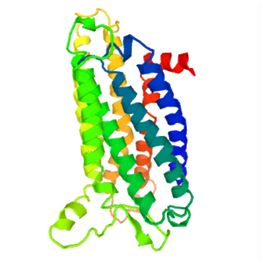Introduction of PTGER3
PTGER3, also known as EP3, is a prostaglandin receptor for prostaglandin E2 (PGE2) encoded by the human gene PTGER3. It is one of four identified EP receptors, the others being EP1, EP2, and EP4, all of which bind with and mediate cellular responses to PGE2. Besides, it has demonstrated that PTGER3 enables to couples to Gi to suppress PKA activity.
| Basic Information of PTGER3 | |
| Protein Name | Prostaglandin E2 receptor EP3 subtype |
| Gene Name | PTGER3 |
| Aliases | Prostaglandin E2 receptor EP3 subtype, PGE receptor EP3 subtype, PGE2 receptor EP3 subtype, PGE2-R, Prostanoid EP3 receptor |
| Organism | Homo sapiens (Human) |
| UniProt ID | P43115 |
| Transmembrane Times | 7 |
| Length (aa) | 390 |
| Sequence |
MKETRGYGGDAPFCTRLNHSYTGMWAPERSAEARGNLTRPPGSGEDCGSVSVAFPI TMLLTGFVGNALAMLLVSRSYRRRESKRKKSFLLCIGWLALTDLVGQLLTTPVVIV VYLSKQRWEHIDPSGRLCTFFGLTMTVFGLSSLFIASAMAVERALAIRAPHWYASH MKTRATRAVLLGVWLAVLAFALLPVLGVGQYTVQWPGTWCFISTGRGGNGTSSSHN WGNLFFASAFAFLGLLALTVTFSCNLATIKALVSRCRAKATASQSSAQWGRITTET AIQLMGIMCVLSVCWSPLLIMMLKMIFNQTSVEHCKTHTEKQKECNFFLIAVRLAS LNQILDPWVYLLLRKILLRKFCQIRYHTNNYASSSTSLPCQCSSTLMWSDHLER |
Function of PTGER3 Membrane Protein
This PTGER3 receptor serves several functions. First, inhibition of the PGE2-EP3 pathway underlies the ability of aspirin and other Nonsteroidal anti-inflammatory drugs to reduce fever caused by inflammation in animals and, possibly, humans. Then, EP3 receptor-deficient mice and/or wild type mice treated with an EP3 receptor agonist are similarly protected from allergic responses in models of allergic conjunctivitis and contact hypersensitivity. Thus, EP3 appears to serve an important role in reducing allergic reactivity at least in mice. Third, studies with mice, guinea pig, and human tissues and in guinea pigs indicate that PGE2 operates through EP3 to trigger cough responses.
 Fig.1 Structure of PTGER3 membrane protein.
Fig.1 Structure of PTGER3 membrane protein.
Application of PTGER3 Membrane Protein in Literature
This article demonstrates that using both genetic and functional analyses, EP3 could be a key player in the pathogenesis of SJS/TEN accompanied by ocular complications.
This article reveals that the EP3 receptor provides endogenous pain control and that selective activation of EP3 receptors may be a unique approach to reverse inflammatory pain. Importantly, they identified the EP3 receptor in the joint nerves of patients with painful osteoarthritis.
The article shows that prostaglandin E2 EP3 receptor contributes to thrombin-induced brain damage via Rho-Rho kinase-mediated cytotoxicity and proinflammatory responses.
This article reveals that the building up of PGE2 during the progression of AD leads to specific impairment of hippocampal presynaptic plasticity and highlights EP3 receptors as a potential target to alleviate cognitive deficits in AD.
The article reveals that Prostaglandin E2 produced within the ovarian follicle is necessary for ovulation. Prostaglandin E2 is recognized by four distinct G-protein coupled receptors. Among them, PTGER3 (also known as EP3) is unique. Differential expression of EP3 isoforms may yield different intracellular responses to prostaglandin E2 in granulosa cell subpopulations.
PTGER3 Preparation Options
To obtain the soluble and functional target protein, the versatile Magic™ membrane protein production platform in Creative Biolabs enables many flexible options, from which you can always find a better match for your particular project. Aided by our versatile Magic™ anti-membrane protein antibody discovery platform, we also provide customized anti-PTGDR3 antibody development services.
As a forward-looking research institute as well as a leading customer service provider in the field of membrane protein, Creative Biolabs has won good reputation among our worldwide customers for successfully accomplishing numerous challenging projects including generation of many functional membrane proteins. Please feel free to contact us for more information.
All listed services and products are For Research Use Only. Do Not use in any diagnostic or therapeutic applications.